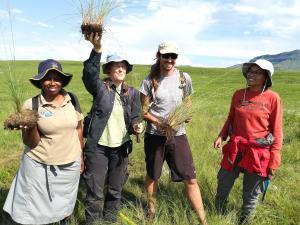In with the old: taking the long view when restoring grasslands
Restoration science and practice are critical in combatting the loss of old-growth grasslands and the loss of biodiversity.
JOHANNESBURG , GAUTENG , SOUTH AFRICA , August 5, 2022 /EINPresswire.com/ -- Grassland restoration has often been trampled underfoot in the rush to score carbon credits by planting trees, and undermined by the assumption that degraded grasslands are easily fixed because they are thought of as relatively young habitats.An article in Science by Elise Buisson, Sally Archibald, Alessandra Fidelis and Katharine N. Suding argues strongly that restoration interventions should be long-term, and benchmarked by an understanding of the complexities of ancient grasslands. Such spaces have been built over centuries into ecosystems of high species diversity, whose resilience to climate change lies mostly out of sight, below the ground. The authors highlight that land conversion – to cultivation or plantation forestry – is irreversible: i.e. it is highly unlikely that these systems can ever be restored to their old-growth state. Therefore they argue that conversion should be avoided wherever possible, but also set out some practical restoration options for the Earth’s grassy ecosystems that use knowledge of the unique needs of their biodiversity to promote old-growth characteristics.
Grasslands constitute almost 40% of the terrestrial biosphere, and on top of providing habitat for a great diversity of plants and animals, contribute to the livelihoods of about one in eight people in the world. Nevertheless, they are imperilled by massive land conversion for intensive agriculture and silviculture (forestry), mining, woody encroachment and species invasion “driven by altered fire and grazing regimes”.
Land-use changes to, for example mining or cultivation, and altered disturbance regimes, put belowground structures (e.g. bud banks) at risk of degradation sufficiently serious to push grasslands over a threshold beyond which restoration may be difficult, or take decades to achieve. This makes it imperative to protect old-growth grasslands, “particularly from the threats that affect belowground processes and structure, as we cannot rely on restoration to guide complete recovery after such degradation,” say the authors.
Numerous studies across six continents show that secondary grasslands may take at least a century, “and more often millennia, to recover their former species richness”. Less is known about how long it might take for belowground soil and structure development, but it is likely to follow the same timeline.
Research is vital in establishing the extent of the problem and the best way to resolve it. Scientists at Wits University's Future Ecosystems for Africa programme, funded by Oppenheimer Generations Research and Conservation, are researching three key questions regarding grasslands restoration:
1. Quantifying the extent of transformed grasslands in Africa.
2. Quantifying the rates at which biodiversity and soil carbon recovers after ploughing/tillage in different African grasslands.
3. Working with biodiversity organisations and policy makers to develop incentives for "avoided conversion" of grassland, similar to the "avoided deforestation" incentives that are part of REDD (Reducing Emissions from Deforestation and forest Degradation).
They propose three considerations to guide restoration interventions - Embrace and manage disturbance-vegetation feedbacks, breaking the cycle of invasion and old-growth grassland species
Climate change
Climate controls the distribution of grasslands, and climate change may require a shift in restoration trajectories depending on species best able to tolerate future conditions. Decisions may be influenced not only by which species to have at a given site, but also functional diversity, soil structure and the belowground component. This will allow the system to recover from an extreme event, as the presence of a viable bud bank and underground storage organs ensures the resilience of the system. In spite of the difficulties climate change presents to restoring old-growth grasslands, the authors expect that prioritising belowground complexity and functional diversity should enable resilience while maintaining the character and services that embody these systems.
Outlook
Restoration science and practice are critical in combatting the loss of old-growth grasslands and the loss of biodiversity. Tree planting in grasslands as a way of restoration, and the conversion of arable land to agriculture, are irreversible actions which ignore the belowground, soil-locked carbon storage in old-growth grasslands.
The authors warn of the hard road ahead, littered with challenges, but are confident that viewing grassland restoration as assembly towards old-growth characteristics with unique biota and belowground complexity, “will enable us to achieve ambitious restoration goals for Earth’s grassy ecosystems”.
In conclusion, they “urge conservation initiatives to safeguard against the conversion of old-growth grasslands for treeplanting or tillage agriculture, to maintain our ancient biodiverse grasslands with appropriate disturbance regimes, and to emphasise the long-term restoration of grasslands in efforts to restore Earth’s biodiversity”.
Professor Sally Archibald
UNIVERSITY OF THE WITWATERSRAND
email us here
Legal Disclaimer:
EIN Presswire provides this news content "as is" without warranty of any kind. We do not accept any responsibility or liability for the accuracy, content, images, videos, licenses, completeness, legality, or reliability of the information contained in this article. If you have any complaints or copyright issues related to this article, kindly contact the author above.

